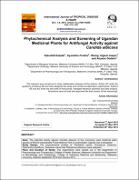| dc.contributor.author | Kakudidi, Esazah. | |
| dc.contributor.author | Ayorekire, Fredric | |
| dc.contributor.author | Ogwal-Okeng, Jasper | |
| dc.contributor.author | Anywar, Godwin | |
| dc.date.accessioned | 2020-09-11T09:38:04Z | |
| dc.date.available | 2020-09-11T09:38:04Z | |
| dc.date.issued | 2015 | |
| dc.identifier.citation | Esazah, K., Fredric, A., Jasper, O., & Godwin, A. (2015). Phytochemical analysis and screening of ugandan medicinal plants for antifungal activity against candida albicans. International Journal of Tropical Disease & Health, 9(1), 1-8. | en_US |
| dc.identifier.issn | 2278–1005 | |
| dc.identifier.uri | https://hdl.handle.net/123456789/158 | |
| dc.description.abstract | Aims: The potential activity against Candida albicans of five commonly used medicinal plant
species of Bwindi Impenetrable Forest National Park in southwestern Uganda was investigated.
Study Design: The phytochemical profiles of Tetradenia riparia, Erucastrum arabicum,
Plectranthus lactiflorus, Solanecio mannii and Platostoma africanum were analysed.
Place and Duration of Study: The experiments were carried out in the Department of
Pharmacology and Therapeutics, College of Health Sciences, Makerere University and Department
of Microbiology and Parasitology, College of Veterinary Medicine and Biosecurity, Makerere
University, between September 2012 and January 2013.
Methodology: The Agar well diffusion method was used to measure the antifungal activity against
Candida albicans (ATCC 10231). The Minimum Inhibitory Concentration (MIC) was determined by
the serial dilution method and the phytochemical analyses were made by standard of the plant
extracts phytochemical tests.
Results: Antifungal activity of both ethanol and diethylether extracts of Tetradenia riparia
surpassed the Nystatine standard (31 and 28 > 25, respectively) as well as those of other four plant
species. The MIC values for the ethanol and ether crude extracts were 0.0312 and 0.0156 g/ml
respectively. The plant species tested proved to be positive for different phytochemicals including
tannins, coumarins and steroidal glycosides.
Conclusion: Generally, all plant species proved to be active against Candida albicans. Tetradenia
riparia exhibited the highest antifungal activity and it is considered to be a potential source of
antifungal drugs. | en_US |
| dc.language.iso | en | en_US |
| dc.publisher | International Journal of Tropical Disease & Health | en_US |
| dc.subject | Fungal infections | en_US |
| dc.subject | Herbal medicine | en_US |
| dc.subject | Bwindi | en_US |
| dc.subject | Candida albicans | en_US |
| dc.subject | Medicinal plants | en_US |
| dc.subject | Tetradenia riparia. | en_US |
| dc.title | Phytochemical Analysis and Screening of Ugandan Medicinal Plants for Antifungal Activity against Candida albicans | en_US |
| dc.type | Article | en_US |

